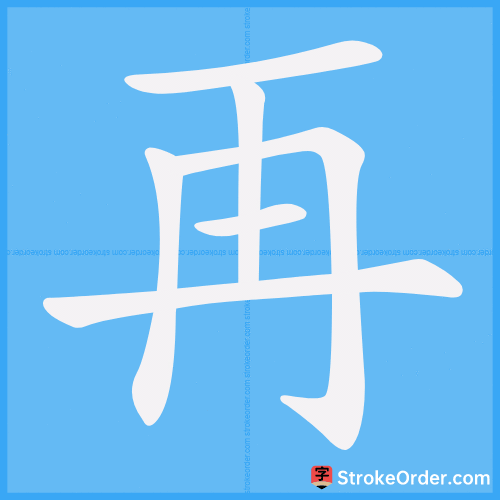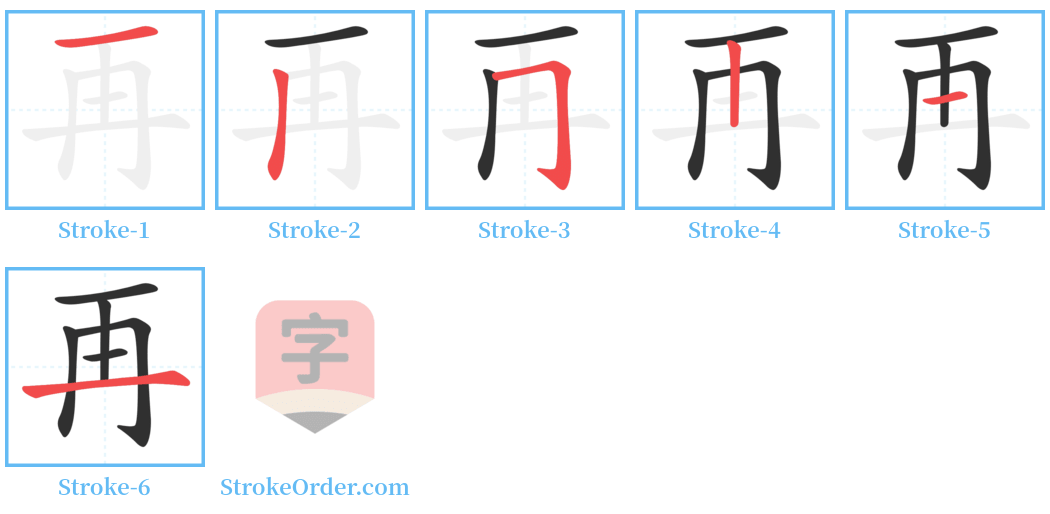再 Stroke Order
Animated Stroke Order of 再

Stroke Order Diagrams for 再

Step-by-Step Handwriting Guide for 再

Learn to Write Chinese Characters with Video Tutorials
Watch the video of writing the Chinese character "再", learn the correct stroke order (笔顺) of the character "再", and master the standard way of writing the character "再".
Free Printable Handwriting Practice with Stroke Order: 再
Printable Writing Practice Worksheet of "再" in Portrait Orientation (Tian Zi Ge)

Printable Writing Practice Worksheet of "再" in Landscape Orientation (Tian Zi Ge)

Information of 再
Pinyin
zài
Radical
冂
Strokes
6 strokes
Usage
★★★★★
Definition
again / once more / re- / second / another
再 [zài]
【Basic Meaning】: Second time
1. 两次;第二次:~次。一而~,~而三。
(Two times; second time: one time and then the second, and then the third.)
2. 重复;继续:良辰难~。青春不~。
(Repeat; continue: good times are hard to repeat. Youth cannot be repeated.)
3. 副词。(①表示又一次:~接~厉。一错~错。)
(Adverb: (i) indicates another time: again and again. One mistake will be repeated.)
再 [zài]
【Adverb】
1. 事情或行为重复,继续 ([En.] again; afresh; once again)
(Things or actions repeat or continue.)
2. 重,重新 ([En.] anew)
(Again, restart.)
3. 更,更加 ([En.] once more) — 表示程度
(More, even more — indicates degree.)
4. 另,另外 ([En.] another)
(Another, different.)
5. 与否定词配合使用,强调情况的普遍性 ([En.] in any case)
(Usually used with negations to emphasize the universality of the situation.)
6. 用于让步句,常同“也”、“都”配合使用,有“即使多么”、“不管怎样”的意思
([En.] regardless of the circumstances.)
7. 表示转折,相当于“却”、“也” ([En.] but; yet)
(Indicates a turn, equivalent to "but" or "also.")
8. 表示两种行为或情状并举、并存,相当于“且…且”、“又…又”
([En.] indicates the coexistence of two actions or situations, equivalent to "both... and..." or "also... also.")
【Symbolic Meaning】: Second time
1. 同本义 ([En.] another time)
(Same as the original meaning.)
2. 两次 ([En.] two times; doubly; twice)
(Two times; doubly; twice.)
又如:再录一堂(复审一次);再速(再请);再二(第二次,再次);再之(第二次,第三次);再眠(指蚕第二次蜕皮时的不食不动状态)
(For example: Record one more lesson (reexamine one time); request again; the second time; again; referring to silkworms when they shed their skin for the second time and do not eat or move.)
1. 事情或行为重复,继续 ([En.] again; afresh; once again)
(Things or actions repeat or continue.)
2. 重,重新 ([En.] anew)
(Again, restart.)
3. 更,更加 ([En.] once more)
(More, even more.)
4. 另,另外 ([En.] another)
(Another, different.)
5. 与否定词配合使用,强调情况的普遍性 ([En.] in any case)
(Emphasizes universal situations when combined with negation.)
6. 用于让步句,常同“也”、“都”配合使用,有“即使多么”、“不管怎样”的意思
([En.] meaning "no matter how," "regardless.")
7. 表示转折,相当于“却”、“也” ([En.] but; yet)
(Indicates contrast, equivalent to 'but' or 'also.')
8. 表示两种行为或情状并举、并存,相当于“且…且”、“又…又”
([En.] indicating simultaneous actions or situations, equivalent to "both... and..." or "also... also.")
to be reborn / to regenerate / to be a second so-and-so (famous dead person) / recycling / regeneration
to bow again / to bow twice (gesture of respect in former times) / (in letters, an expression of respect)
to give a new lease of life / to reconstruct / to reform / to rework / to recycle / to reproduce (copies, or offspring) / restoration / restructuring